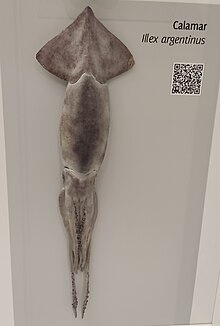Illex argentinus
| Argentine shortfin squid | |
|---|---|

| |
| Illex argentinus dissected in the National Museum of Natural History of Uruguay. | |
| Scientific classification | |
| Domain: | Eukaryota |
| Kingdom: | Animalia |
| Phylum: | Mollusca |
| Class: | Cephalopoda |
| Order: | Oegopsida |
| Family: | Ommastrephidae |
| Genus: | Illex |
| Species: | I. argentinus |
| Binomial name | |
| Illex argentinus (Castellanos, 1960)[2] | |
| Synonyms | |
| |
Illex argentinus, commonly known as the Argentine shortfin squid, is a species of squid in the family Ommastrephidae from the south western Atlantic Ocean.
It is one of the most commercially fished species of squid, with 511,087 tons harvested in 2002, or 23.3% of the entire squid harvest.[3]
I. argentinus is most prevalent along the coasts of South America, in Argentina, Brazil and in the Falkland Islands (Malvinas) in the Patagonian shelf. Some of the largest fisheries in the world are along these coasts, capturing millions of pounds of these shortfin squid a year.[1][4]
Although they are relatively small species, they tend to form shoals, making them easy to be caught by fisheries.[5]
Physical features
The Argentine shortfin squid has a relatively strong mantle and fins. Its arms are long, with male arms significantly longer than female arms.[6]
Habitat
Argentine shortfin squid can live in a variety of depths, ranging from the surface all the way to 800 m.[1] Although the Argentine shortfin squid has a wide geographic distribution, it is an oceanic species, as they aggregate on the sea floor. They feed on other species of squid, pelagic crustaceans and crabs, shrimp, and other small fish.[7] Throughout the lifetime of an Argentine shortfin squid, many different prey of different sizes are eaten. On the other hand, predators of the Argentine shortfin squid include marine mammals, fishes, and birds. Predators and prey depend on the geographic location of the species of the Argentine shortfin squid, as they are a migratory species. The wide variety of prey and predators reflects this. During the fall and winter months, the Argentine shortfin squid is abundant on the lower shelf of the sea, at a depth of about 200 m.
Life history
Argentine shortfin squids reproduce through internal fertilization.[8] During the mating season, which lasts throughout the summer, they lay thousands of eggs on the sea floor. The eggs develop at different rates, so they do not all hatch together. They have a relatively short life span, living up to 1–2 years. The Argentine shortfin squid migrates between spawning grounds, feeding grounds, and back during their one-year life cycle. Mature squid like to migrate northward to spawning grounds, travelling closer to sea floor at night and by the surface during the day.[9] This squid is small, starting at only one millimeter and growing to a maximum body length of approximately one foot, while its tentacles are 9 inches long. After the Argentine shortfin squid reproduces once, it dies.
Industrial use

It is one of the planet's most economically significant invertebrate species. As many as 2.2 billion pounds of Argentine shortfin squid have been captured in only one fishing season. From 1988 to 2003 about 700,000 tons of Argentine shortfin squid were captured.[5] Argentine shortfin squid are so important as they make up the second largest fishery in the world by weight.[1]
Fisheries use bright lights to attract the squid to the surface at night, and then capture them with large nets. Fisheries additionally use both trawlers and jigging vessels to capture the shortfin squid. Although so many Argentine shortfin squid are removed from the coasts every year, populations bounce back, probably because of their short lifespan.[8] They are thus labeled a species of least concern. That being said, however, since 2010 stocks have steadily been declining. It is suggested that environmental changes instead of fishery impacts have caused this decline. It is essential that the nations that house this species must cooperate in order to ensure that the species is used by fisheries in a sustainable manner.
References
- ^ a b c d Barratt, I. & Allcock, L. (2014). "Illex argentinus". The IUCN Red List of Threatened Species. 2014: e.T163246A989453. doi:10.2305/IUCN.UK.2014-1.RLTS.T163246A989453.en. Downloaded on 10 March 2018.
- ^ Julian Finn (2016). "Illex argentinus (Castellanos, 1960)". World Register of Marine Species. Flanders Marine Institute. Retrieved 10 March 2018.
- ^ Rodhouse, Paul G (2005). "Review of the state of world marine fishery resources: Fisheries technical paper". World Squid Resources (447). FAO. ISBN 92-5-105267-0.
- ^ "Chinese Fishing Vessels' 'Floating Cities' Prey on Latin American Seas". Diálogo Américas. 2023-06-05. Retrieved 2024-05-17.
- ^ a b Chiu, Tsan-Yu; Chiu, Tai-Sheng; Chen, Chih-Shin (September 2017). "Movement patterns determine the availability of Argentine shortfin squid Illex argentinus to fisheries". Fisheries Research. 193 (1): 71–80. doi:10.1016/j.fishres.2017.03.023 – via ResearchGate.
- ^ Bazzino Ferreri, Gastón A.; Quiñones, Renato A.; Norbis, Walter (December 2005). "Environmental associations of shortfin squid Illex argentinus (Cephalopoda: Ommastrephidae) in the Northern Patagonian Shelf". Fisheries Research. 76 (3): 401–416. doi:10.1016/j.fishres.2005.07.005 – via ResearchGate.
- ^ Alvarez Perez, José, yTiago Nascimento Silva, Rafael Schroeder, Richard Schwarz, and Rodrigo Silvestre Martins (2009). "Biological patterns of the Argentine shortfin squid Illex argentinus in the slope trawl fishery off Brazil". Latin American Journal of Aquatic Research, 37(3), 409-427.
- ^ a b Sacau, M., Pierce, G., Wang, J., Arkhipkin, A., Portela, J., Brickle, P., Cardoso, X. (2005). The spatio-temporal pattern of Argentine shortfin squid Illex argentinus abundance in the southwest Atlantic. Aquatic Living Resources, 18(4), 361- 372.
- ^ Rodhouse, Paul G.K.; Arkhipkin, Alexander I.; Laptikhovsky, Vladimir; Nigmatullin, Chingis & Waluda, Claire M. (2013). "Illex argentinus, Argentine shortfin squid". Advances in Squid Biology, Ecology and Fisheries. Part II. 23 (4): 109–148.
- ^ "Fisheries and Aquaculture - Global Production". Food and Agriculture Organization of the United Nations (FAO). Retrieved 2024-05-06.

